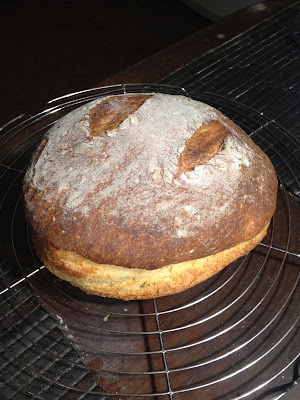No-knead crusty white bread from King Arthur Flour is an easy recipe to make with wonderful results.
Ingredients:
6 1/2 -7 1/2 cups of all-purpose flour
3 cups of warm water
1 T salt
1 1/2 T active dry or instant yeast
Method:
If you are scooping the flour out of the bag, use the 6 1/2 cups; if you are sprinkling your flour into the measuring cup, use the 7 1/2 cups.
Sift flour into a large (8 quart or larger) bowl; add yeast on one side of the bowl, and add salt on the other (salt and yeast are not exactly friends). Heat the water to around 105°F (no hotter than 112° or you'll kill the yeast).
Add the water and mix thoroughly until dough will form a ball. If you are mixing by hand, use a wooden spoon or silicone spatula (it helps if the spatula is all one piece). If you are using a stand mixer, use the paddle attachment and remember to never mix any dough above speed 2. If you find that the dough is enveloping your paddle, it's ok to switch to the dough hook, but just make sure that all the little bits on the bottom are being thoroughly incorporated.
Once thoroughly mixed, the dough will look like this:
The dough will be sticky...
Cover the bowl with plastic wrap (a shower cap works really nicely) and allow dough to rise in a warm, draft-free spot for 2 hours.The KAF instructions say let your dough rise at room temperature, but I let all my doughs rise in my oven with the heat off. I have an oven with a pilot light, so it's a nice, cozy spot for the dough to get big and puffy. If you have no pilot light, but your oven has a light, you can leave the light on and allow the dough to rise in the oven (which is turned OFF, but with the light ON). Another nie alternative is to turn your oven on to 100°F or 200°F for a few minutes and the turn it off. Stick the dough in there (remember to make sure your oven is off as the dough rises) and pull out in 2 hours.
After rising the dough should look like this:
Put the dough in the refrigerator (covered) and refrigerate at least 2 hours or up to 14 days. You will know if the dough has gone rancid. Your nose is your best friend when it comes to cooking, baking and general food safety. Yes, I know there are some germs that you cannot smell (botulism, E. coli, salmonella and listeria for instance) but if the dough has gone bad, you will know, trust me.
When ready to bake, prepare a baking sheet with parchment paper, or if you are using a cloche, line the cloche (or dutch oven) with parchment. Parchment is your friend when baking bread. Grab a hunk of dough (you can comfortably divide this dough recipe into quarters, halves, or thirds) and form into a round, or a log. Plop the dough down on the parchment and sprinkle with flour. Allow dough to rise for an hour at room temperature (longer in winter, or if your kitchen tends to be cold). About 40 minutes into the rise (or 20 minutes before you're ready to bake), place an empty METAL pan on the bottom rack of your oven (it is important that this pan be metal; glass or ceramic may break) and preheat the oven to 450°F. About 5 minutes before you are ready to bake, cut a few 1/2" deep slashes into the top of your bread using a sharp knife. this will allow the bread to expand in a uniform way as it bakes.
Heat one cup of water (I usually put the water in a glass measuring cup and nuke it on high for 1 minute). Place your loaf on the top rack of the oven and add the water to the metal pan. It will make a very nice swooshing, sizzling sound. Quickly close the oven door and bake the loaf for 25 to 45 minutes (depending on the size of your loaf....larger loaves need longer baking times) until the bread is a deep golden-brown color.
sometimes, things get wacky and your bread comes out looking like a snake head...
isn't it cute?
This bread bakes up so easily and the dough is easy to make as well. Whether you are a seasoned baker or a novice, this a great bread!
Just look at that crumb...










